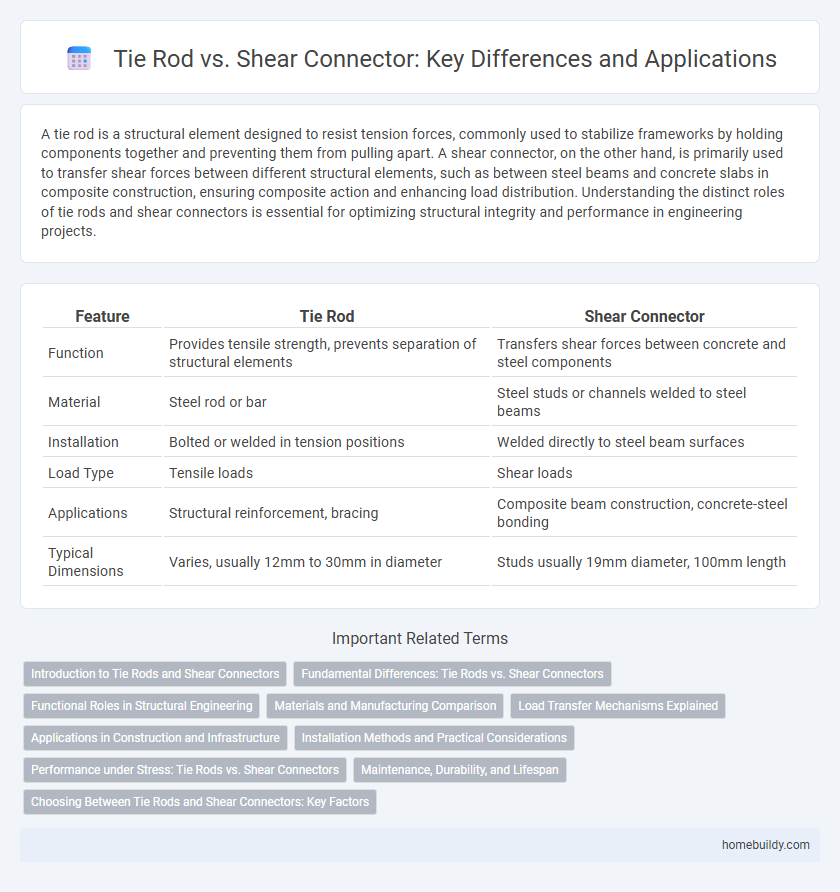A tie rod is a structural element designed to resist tension forces, commonly used to stabilize frameworks by holding components together and preventing them from pulling apart. A shear connector, on the other hand, is primarily used to transfer shear forces between different structural elements, such as between steel beams and concrete slabs in composite construction, ensuring composite action and enhancing load distribution. Understanding the distinct roles of tie rods and shear connectors is essential for optimizing structural integrity and performance in engineering projects.
Table of Comparison
| Feature | Tie Rod | Shear Connector |
|---|---|---|
| Function | Provides tensile strength, prevents separation of structural elements | Transfers shear forces between concrete and steel components |
| Material | Steel rod or bar | Steel studs or channels welded to steel beams |
| Installation | Bolted or welded in tension positions | Welded directly to steel beam surfaces |
| Load Type | Tensile loads | Shear loads |
| Applications | Structural reinforcement, bracing | Composite beam construction, concrete-steel bonding |
| Typical Dimensions | Varies, usually 12mm to 30mm in diameter | Studs usually 19mm diameter, 100mm length |
Introduction to Tie Rods and Shear Connectors
Tie rods are structural components designed to resist tensile forces and maintain stability in frameworks, commonly used in bridges and building supports. Shear connectors, in contrast, transfer shear forces between steel and concrete, enhancing composite action and load distribution in construction. Understanding the distinct functions of tie rods and shear connectors is crucial for optimizing structural integrity and performance in engineering projects.
Fundamental Differences: Tie Rods vs. Shear Connectors
Tie rods primarily serve to resist tensile forces and provide structural stability by connecting parts of a framework to prevent separation under load, whereas shear connectors are designed to transfer shear forces between different materials, such as concrete and steel, enhancing composite action. Tie rods typically consist of steel rods with end fittings, allowing for tension adjustment, while shear connectors are often welded studs or channels embedded in concrete slabs. The fundamental difference lies in their mechanical role--tie rods control tension and maintain alignment, while shear connectors ensure effective load transfer and composite behavior in structural elements.
Functional Roles in Structural Engineering
Tie rods provide tensile strength by resisting pulling forces within structural frameworks, ensuring stability and alignment of components. Shear connectors, in contrast, primarily transfer shear stresses between concrete slabs and steel beams, facilitating composite action and enhancing load-bearing capacity. Both elements serve distinct functional roles critical for the integrity and performance of composite structural systems.
Materials and Manufacturing Comparison
Tie rods are typically manufactured from high-strength carbon steel, utilizing processes such as hot rolling or cold drawing to achieve precise tensile properties and durability required in structural applications. Shear connectors often use composite materials like steel combined with concrete, produced through welding and embedding methods to ensure effective load transfer and composite action. The manufacturing of tie rods emphasizes tensile strength and ductility, whereas shear connectors prioritize shear resistance and bonding capabilities between dissimilar materials.
Load Transfer Mechanisms Explained
Tie rods primarily transfer tensile loads by directly pulling connected components together, providing structural stability and resistance against tension forces. Shear connectors function by transferring shear forces through the interface between two materials, typically embedded in concrete to enhance composite action between steel and concrete elements. Understanding these distinct load transfer mechanisms is crucial for choosing the appropriate reinforcement in structural applications requiring tension versus shear resistance.
Applications in Construction and Infrastructure
Tie rods are primarily used in construction for tension support in frameworks, stabilizing structures such as bridges, buildings, and towers by resisting tensile forces. Shear connectors, in contrast, are embedded in concrete slabs to transfer shear forces between steel beams and concrete, enhancing composite action in bridges and multi-story buildings. Understanding their distinct applications ensures optimal structural performance and safety in infrastructure projects.
Installation Methods and Practical Considerations
Tie rods are typically installed using anchor bolts and adjustable turnbuckles, allowing precise tension control during assembly, whereas shear connectors are welded or cast in place to ensure rigid composite action between steel and concrete. Tie rods offer flexibility in alignment and ease of post-tension adjustments, making them suitable for retrofitting and structures subject to dynamic loads. Practical considerations include the accessibility for maintenance with tie rods and the need for skilled welding in shear connectors, impacting installation time and labor costs.
Performance under Stress: Tie Rods vs. Shear Connectors
Tie rods exhibit superior tensile strength and flexibility under stress, effectively distributing loads and accommodating structural movements without failure. Shear connectors primarily resist shear forces at the interface of connected components but lack the tensile capacity and adaptability of tie rods. Performance under stress demonstrates tie rods' advantage in dynamic load applications, while shear connectors excel in maintaining shear integrity in composite structures.
Maintenance, Durability, and Lifespan
Tie rods require regular inspection to ensure tension integrity, proving easier to maintain compared to shear connectors, which are often embedded and harder to access. The durability of tie rods is enhanced by their corrosion-resistant materials, extending lifespan beyond shear connectors that may suffer from fatigue and corrosion in steel-concrete interfaces. Lifespan of tie rods typically surpasses shear connectors due to simpler maintenance procedures and more effective load distribution under dynamic stress.
Choosing Between Tie Rods and Shear Connectors: Key Factors
Tie rods and shear connectors serve distinct structural purposes, with tie rods primarily providing tensile force resistance and shear connectors enhancing composite action between steel and concrete elements. When choosing between tie rods and shear connectors, factors such as load type, connection flexibility, and construction sequence play crucial roles in determining the optimal solution for structural stability. Engineers must assess project-specific requirements including load distribution, material compatibility, and long-term maintenance to ensure effective performance and durability.
tie rod vs shear connector Infographic

 homebuildy.com
homebuildy.com